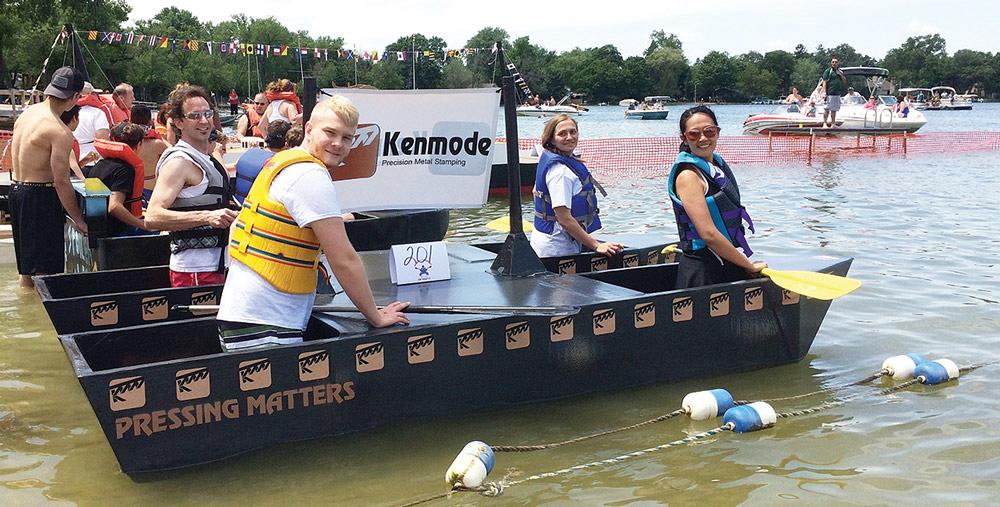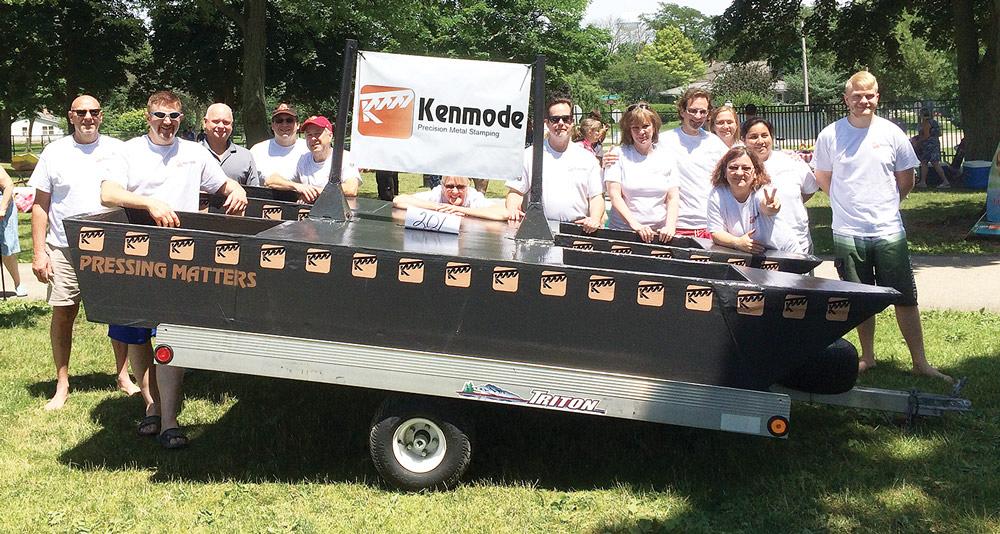Editor-in-Chief
- FMA
- The Fabricator
- FABTECH
- Canadian Metalworking
Categories
- Additive Manufacturing
- Aluminum Welding
- Arc Welding
- Assembly and Joining
- Automation and Robotics
- Bending and Forming
- Consumables
- Cutting and Weld Prep
- Electric Vehicles
- En Español
- Finishing
- Hydroforming
- Laser Cutting
- Laser Welding
- Machining
- Manufacturing Software
- Materials Handling
- Metals/Materials
- Oxyfuel Cutting
- Plasma Cutting
- Power Tools
- Punching and Other Holemaking
- Roll Forming
- Safety
- Sawing
- Shearing
- Shop Management
- Testing and Measuring
- Tube and Pipe Fabrication
- Tube and Pipe Production
- Waterjet Cutting
Industry Directory
Webcasts
Podcasts
FAB 40
Advertise
Subscribe
Account Login
Search
Metal stamper takes to the lake
Design and tooling experts come together to apply metal skills to a cardboard boat
- By Dan Davis
- September 8, 2015
- Article
- Bending and Forming
What do you get when a crew of technically savvy metal formers and tool and die experts are asked to build a boat out of cardboard? Good times.
Maria Avalos, senior human resources generalist for Kenmode Precision Metal Stamping, tossed out the idea that the company could participate in the 31st America’s Cardboard Cup Regatta in Crystal Lake, Ill., on June 27. The regatta is a fundraiser for several northern Illinois charities. Individuals and businesses build cardboard boats and then race them along a 200-yard course at the town’s Main Beach.
Algonquin, Ill.-based Kenmode had never done anything on this level before. Employee recognition programs and cookouts are regular happenings at the company, but none of those activities involve the need for detailed design plans and a chance for some to get very wet.
As a flyer made the rounds at the company, several individuals indicated that they were interested in taking on Crystal Lake.
“Then they say you have to finish it in five weeks,” said Tom Anderson, a Kenmode tooling specialist. The race to the race was on.
The designers started looking online for plans and videos for inspiration and guidance. The one main design criteria was that the boat had to be made of cardboard. The design goal was for no one to go down with the ship.
“We wanted to make the boat simple enough to make, not with all of these radiuses. We wanted to keep it with straight bends,” said Troy Gambrill, a member of Kenmode’s tooling maintenance department. “Then it was a matter of how do you keep the boat afloat being a single. That’s when we decided to go with a catamaran style [see Figure 1].”
Designers drew up a design in AutoCAD®, which was then kicked over to engineering. When the plans were approved, software was used to flatten the designs. Templates were then printed out.
The design staff was concerned about pressure from the water collapsing the high sides of the cardboard boat. To combat that, they laid each layer of the corrugated material in the opposite direction of the layer that preceded it. By the time the final design was complete, the cardboard catamaran had five layers.
The final materials tally for construction included about 60 tubes of liquid adhesive, approximately 25 tubes of caulk to seal the edges, and several rolls of paper box tape (which was selected over duct tape because it was not as likely to shrink and expand when exposed to the elements).

Figure 2
Not to say that the Kenmode cardboard boat was overengineered,
but only 4 inches of the boat submerged
beneath the water surface when Dirk Piening, Max
Schindler (lower left), Analiisa Nelson (far right), and
Gina Bye took to their rowing positions.
Max Bokma, another member of the Kenmode tooling maintenance department, said sealing and painting—two coats of a sander sealer, two coats of a polyurethane sealer, one primer coat, and a black topcoat—required the most amount of time because they could finish only one portion of the boat at a time. The entire finishing process took eight days, which led right up to the day of the race.
The Kenmode cardboard boat represented well in its heat (see Figure 2), which included a cardboard replica of the Titanic and another entry with a dragon’s head. The Kenmode team won its heat, but failed to qualify for the championship round because it took too much time to make its way around the course, which featured two 90-degree turns at the beginning and end. The crew manning the dragon’s head boat got tangled up with the Kenmode team at the first turn, costing them valuable time. (The fastest boat for this year’s regatta, and several years previous, was a skiff-type boat, which finished the course in just under one minute.)
In the end, however, everyone stayed dry. The boat had some water beading but that was about it. The team also enjoyed a day of picnicking and camaraderie.
Other boats ended up in a big dumpster near the finish line. What seemed to be solidly constructed boats at the beginning of the race looked like water-logged pizza boxes at the end.
Looking back on the event, everyone agreed that it was fun applying their expertise to something other than complex metal forms.
“You had people excelling in their own areas—and having fun,” Anderson said.
The Kenmode boat didn’t end up in the dumpster. It resides in the company’s new technology center across the street from the main facility, ready to hit the lake again if the team wants to repeat the adventure.
“Maybe we’ll put a turret and a gun on it and make it a battleship,” Bokma said.
Now that sounds like the perfect project for a precision metal forming company.
About the Author

Dan Davis
2135 Point Blvd.
Elgin, IL 60123
815-227-8281
Dan Davis is editor-in-chief of The Fabricator, the industry's most widely circulated metal fabricating magazine, and its sister publications, The Tube & Pipe Journal and The Welder. He has been with the publications since April 2002.
subscribe now

The Fabricator is North America's leading magazine for the metal forming and fabricating industry. The magazine delivers the news, technical articles, and case histories that enable fabricators to do their jobs more efficiently. The Fabricator has served the industry since 1970.
start your free subscription- Stay connected from anywhere

Easily access valuable industry resources now with full access to the digital edition of The Fabricator.

Easily access valuable industry resources now with full access to the digital edition of The Welder.

Easily access valuable industry resources now with full access to the digital edition of The Tube and Pipe Journal.
- Podcasting
- Podcast:
- The Fabricator Podcast
- Published:
- 04/16/2024
- Running Time:
- 63:29
In this episode of The Fabricator Podcast, Caleb Chamberlain, co-founder and CEO of OSH Cut, discusses his company’s...
- Trending Articles
AI, machine learning, and the future of metal fabrication

Employee ownership: The best way to ensure engagement

Steel industry reacts to Nucor’s new weekly published HRC price

Dynamic Metal blossoms with each passing year

Metal fabrication management: A guide for new supervisors

- Industry Events
16th Annual Safety Conference
- April 30 - May 1, 2024
- Elgin,
Pipe and Tube Conference
- May 21 - 22, 2024
- Omaha, NE
World-Class Roll Forming Workshop
- June 5 - 6, 2024
- Louisville, KY
Advanced Laser Application Workshop
- June 25 - 27, 2024
- Novi, MI



























